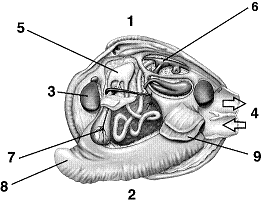During cell division, it is essential that the genetic material be distributed equally to the two daughter cells. This is accomplished through the participation of which one of the following organelles?
A) centrioles
B) ribosomes
C) peroxisomes
D) Golgi apparatus
E) nucleolus
A
You might also like to view...
A newborn baby dies soon after birth because her diaphragm and rib cage muscles failed to contract and she was unable to breathe on her own. Examination of the baby’s DNA revealed that she had a genetic mutation in a gene that encoded a calcium-binding protein. Which protein was most likely defective in the baby?
A. actin B. myosin C. acetylcholine D. tropomyosin E. troponin Clarify Question · What is the key concept addressed by the question? · What type of thinking is required? Gather Content · What do you know about the proteins the bind to calcium in a muscle contraction? What other information is related to the question? Choose Answer · Given what you now know, what information is most likely to produce the correct answer? Reflect on Process · Did your problem-solving process lead you to the correct answer? If not, where did the process break down or lead you astray? How can you revise your approach to produce a more desirable result?
The enzyme that forms a transport channel in the inner membrane of the mitochondria and uses the potential energy of the proton gradient to form ATP is the
A. FADH2 synthase. B. hydrogen synthase. C. NADH synthase. D. ADP synthase. E. ATP synthase.
Which of the following contain enzymes, are the
main organelles of intracellular digestion, and can digest whole cells? a. Golgi bodies b. vesicles c. peroxisomes d. lysosomes e. endoplasmic reticula
Refer to Figure 31-5. Which number has been placed on the dorsal surface?
A. 1
B. 2
C. 3
D. 4
E. 8